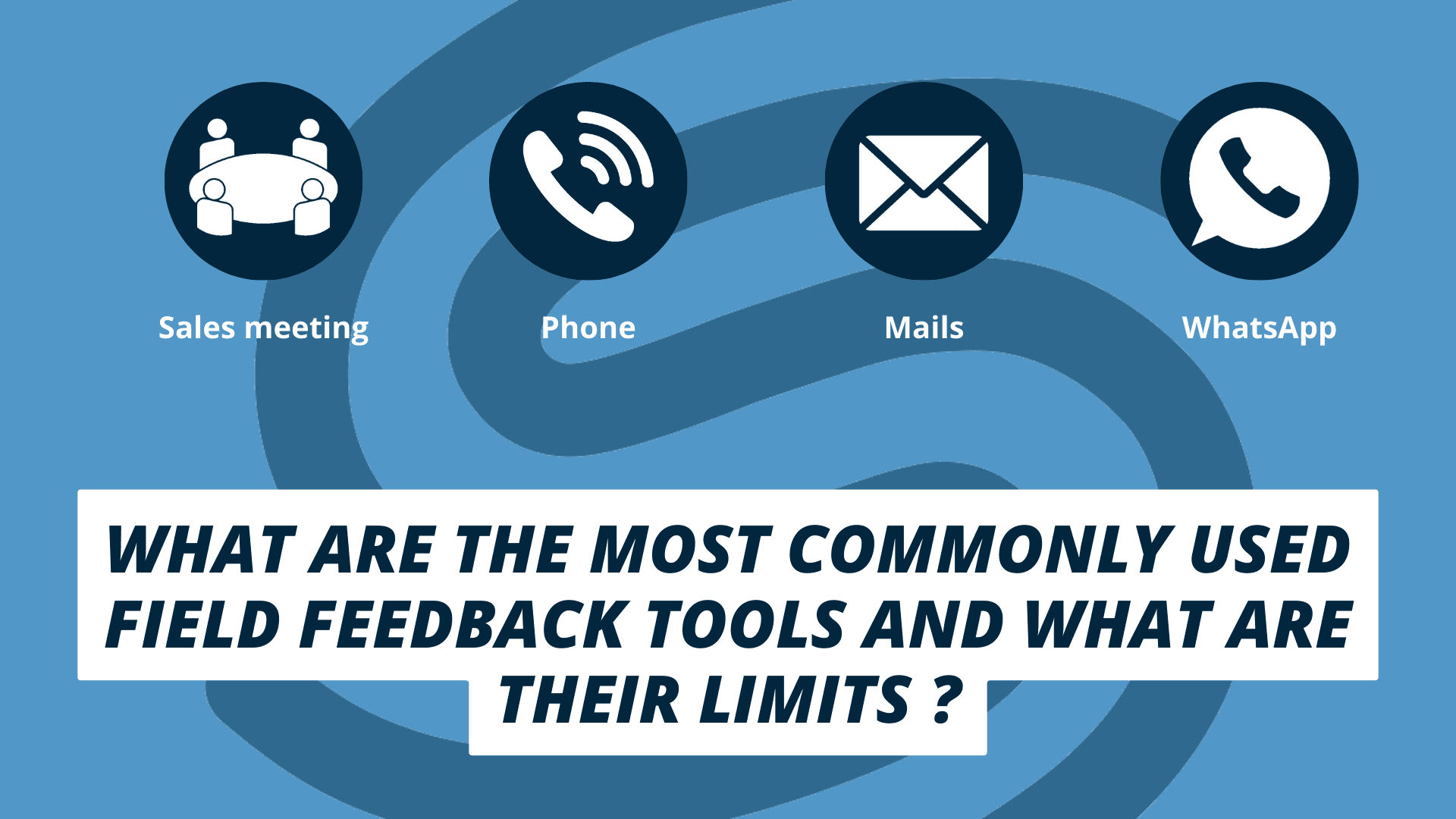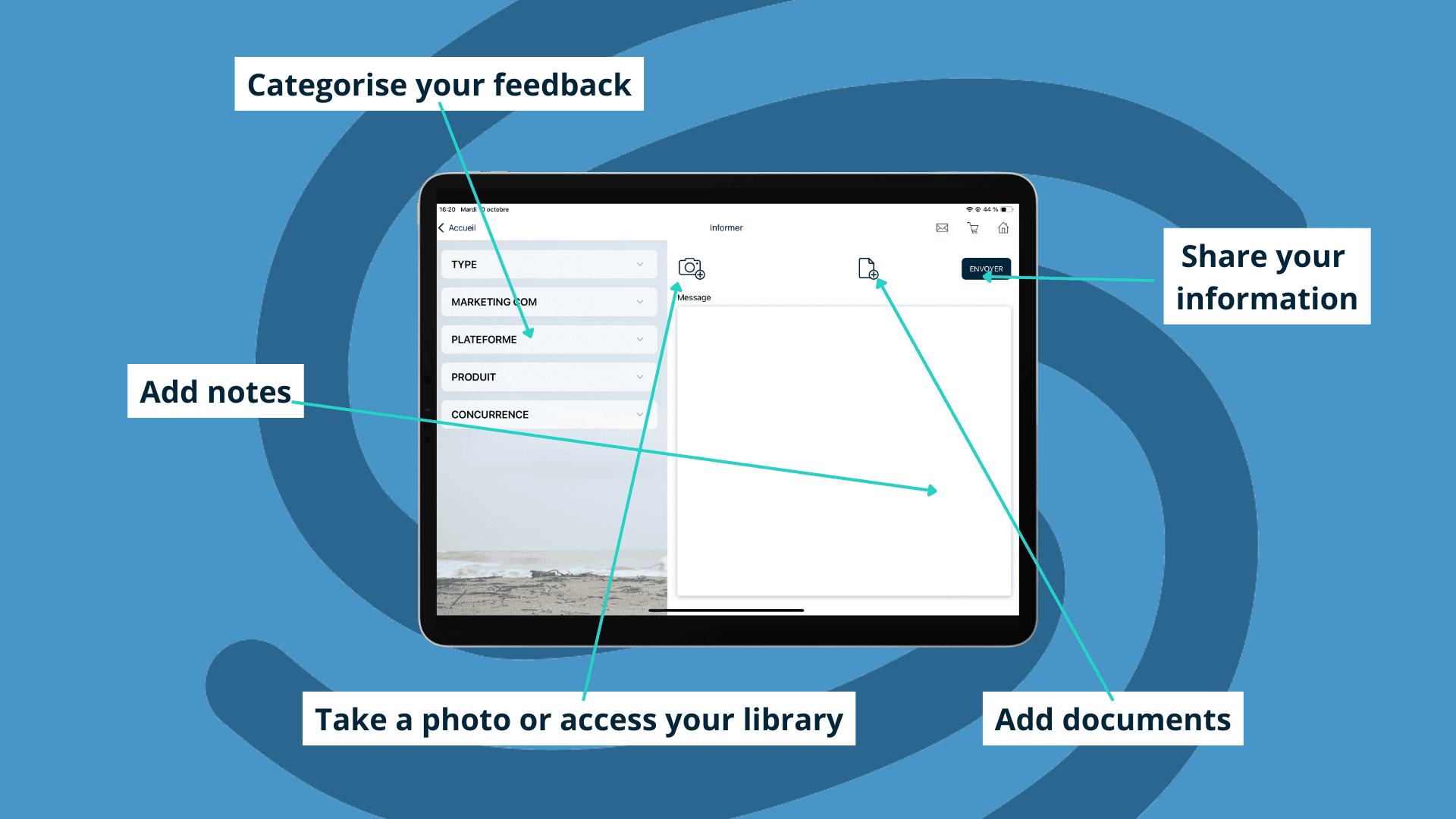
Blog
How can we stimulate and improve the quality of field feedback from sales reps ?

What is field feedback?
Field feedback refers to the process by which sales teams share information and observations from the field with their sales management and with marketing management. This feedback is invaluable, as it provides a live view of what's happening in the field. The information shared can take many different forms: observations concerning the competition, customer feedback, a sales opportunity, a problem encountered during a promotional offer, an invitation to a trade show, the implementation of an animation, a suggestion for improvement or simply specific customer needs identified.
What are the most commonly used land-survey methods and their limitations?

There's no shortage of ways to provide feedback in the field, but are they practical and, above all, effective? Between sales meetings, cell phones, e-mails and WhatsApp, sales reps are spoilt for choice when it comes to feeding back information. However, this diversity of channels in no way guarantees the quality of the information shared, and often leads to problems of data dispersion. There are two questions to ask when it comes to reporting information: how? In other words, what is the most effective way to ensure that my feedback is seen and processed, and by whom? How can I be sure that the right person will ultimately be in contact with my feedback? Problems of choice of channel and recipient can therefore compromise the effectiveness of field feedback. Between the information communicated by the salesperson and that which will actually be received, and hopefully processed, the essence of the message can be lost and diluted in the mass of information to which an organization is exposed on a daily basis.
As long as the information reported is not structured, centralized and routed to the right contact using the right channel, field feedback will not be effective! Let's take the case of intermediaries, who also hamper the effectiveness of field feedback. In practice, it's quite rare for a sales rep to be able to talk directly to the decision-maker or the person in charge of the subject who will be able to analyze and take action. This is all the more true in large companies or those with geographically dispersed teams. More often than not, and due to the lack of appropriate tools, the salesperson will share the information with his or her N+1 in a meeting or via a phone call, to the manager of a department not concerned by the request, or simply ask his or her colleague in the field to share the observation with the person in question. The process of escalating information becomes long and complicated. The result? Information circulates poorly, becomes diluted and is eventually lost. As a result, the information is not processed and, over time, sales reps stops reporting. All these observations raise questions about the effectiveness of the channels used to provide feedback in the field:
1. Sales meeting :
The sales meeting provides a framework in which sales reps can express themselves orally with their manager. In addition to facilitating the follow-up of actions taken, the sales meeting is an excellent opportunity to motivate teams and guide them towards new objectives. But does this make it the ideal channel for field feedback? On the face of it, yes, but there are several risks. Is the manager concerned by the subject at hand? Is there a risk of subjective interpretation? Will the information shared be passed on? To the right person? Is this information always identical to what is observed in the field? Will it be transmitted at the right time?
2. Mails :
Over the years, e-mail has established itself as the predominant means of communication within companies. Sending an e-mail: it's fast, efficient, and you can share anything with anyone! However, there are questions to be asked about the relevance of this channel for field feedback. Is the information transmitted by e-mail precise enough? Does it provide enough context for an overall understanding of the message? Is the recipient really concerned by the subject? Does the sales rep know the right person to contact? If the message isn't read immediately or during the day, isn't there a risk that it will get lost in the recipient's e-mail flow and never be processed? What's more, there's no way to homogenize the feedback (e.g., no fields to categorize the information), which makes it hard to exploit the data behind it. The recipient is often overwhelmed by the volume of e-mails, which makes it difficult to manage, prioritize and prioritize the information sent by the sales rep.
3. WhatsApp:
WhatsApp is the best! As well as being available on smartphones, sending messages is both free and instantaneous. The ability to create groups and share different types of content (files, photos and videos) makes it an excellent means of communication. However, managing WhatsApp discussions can become chaotic if information is not well organized. Creating a WhatsApp newsgroup helps to centralize the information reported, but the administrator may find it difficult to sort, retrieve or exploit the data due to the sheer volume of messages exchanged in the conversation. The flow of information is in itself a weakness when it comes to providing effective field feedback and exploiting it over time.
4. Phone :
The telephone offers fast, direct communication, but it does have its limitations. Do I have the contact details of the right person? Is he or she available when I call? If not, should I leave a message or call back? Telephone conversations are not recorded, which means that if the information is misunderstood, it's difficult to check unless you call the person back, which can be a waste of time. Even if the information is understood correctly, the caller is not reminded of it. It's up to them to remember. In terms of follow-up, it's also complicated to trace information shared over the phone. Who passed on the information? When and at what time? Can the degree of importance of the subject be traced? Can we guarantee an analysis of the feedback from the field? Nor does the telephone allow for precise contextualization of the information transmitted.
Why is it important to stimulate feedback from the field?

It's essential to stimulate feedback from the field, because this information is rich, instantaneous and free, and it's also a valuable source of intelligence for any company (competitive intelligence, customer satisfaction, market opportunities, etc.). Sales reps need to be guided and encouraged to do this for the1st time, so that they can enter into the process. If this information is then processed, returned to the sender and thanked, whatever the outcome of the final decision, the foundations of a virtuous circle will be laid. In fact, a feedback channel that has been processed and sent back to its sender is proof that it's working. The next step will be to help them discover all the types of information that can be passed on, to stimulate them in this activity and to highlight them from time to time. It's no coincidence that these feedback engines are often associated with gamification. It becomes fun, useful, rewarding and stimulating for the salesperson.
Encouraging feedback from the field offers numerous advantages, such as real-time monitoring, a shared knowledge base, improved company responsiveness, improved customer satisfaction, more motivated sales teams and stronger synergies between field teams and management, as well as between Sales & Marketing.
What are the different types of field feedback?

The type of information that the salesperson is able to retrieve depends very much on the situation he or she is confronted with. As a general rule, all types of information can be reported, provided that the tool used allows it. Among the types of information that can be fed back are : competitive information (e.g. competitor outlet promotions, price surveys, launch of a new offer/service, opening of a new store...), customer feedback (whether satisfaction, dissatisfaction or ideas forimprovement), merchandising (such as the installation of a gondola head, the restocking of a department, the installation of a window display, or the prices displayed on products during the launch of a promotional offer...), the completion of a site, a sales operation, suggestions (ideas put forward directly by the salesperson)...
As far as format is concerned, everything should be possible, from a simple free-text note to a form or even a photo. The important thing is to make it easy to pass on information and to send it to the right person(s).
Feedback from the field: what's at stake for sales and marketing managers?
1. Stimulate feedback from the field :
How can we encourage sales staff to provide feedback in the field? How can we create a favorable environment that encourages feedback? What means can be put in place to encourage feedback from the field (e.g. challenges, etc.)?
2. Channeling and organizing feedback from the field :
How do you centralize the information reported? How can we ensure that information is shared with the right people? How can we ensure that the information received is usable by management? How can we facilitate the transmission of information between the field and head office?
3. Enter a virtuous circle of feedback :
How do you create a habit around information feedback? How can we get sales reps to spontaneously report information?
Digitalize your field feedback with Sales Enablement for greater efficiency

The Sales Enablement application acts as an effective catalyst to facilitate field feedback from a smartphone, tablet or PC. First and foremost, this feedback functionality should enable information to be categorized at source, so that it can be sent to the right contacts without the sender having to worry about it. In this way, you'll be able to track down different types of information quickly and easily. The benefit is twofold: you give sales people ideas about the type of information they can pass on to you, and you simplify their lives by guaranteeing that the information is forwarded to the right person. All categories of feedback can be archived and configured directly from the Back-Office, enabling information flows to be adapted, completed and developed according to the needs of managers and marketing teams alike. The structuring of data makes it easier to use at head office, which in turn enables all the ensuing sales operations to be carried out successfully.
Rather than seeing it as a constraint or an additional task to be carried out on a daily basis, field feedback becomes an activity in which sales reps finds real added value. Thanks to the gamification system embedded in the application, sales reps can be awarded badges/points for the number of photos shared, the number of likes on a photo... but also for the way in which field feedback is carried out. This feature not only improves the quality of field feedback, but also stimulates it through incentives managed by management.
Another strong point of this "Feedback" functionality lies in its potential to improve field feedback methods. Indeed, thanks to its Instagram-like feed options, the sales force will be able to access content shared by each of sales reps for certain types of information, while others will only be seen by central teams. This feature makes it an excellent way to share best practices with the entire sales force. And let's not forget that working in the field isn't always easy on a day-to-day basis. By centralizing the information shared via a common tool, this information, visible to Sales & Marketing teams, helps to enhance and recognize the work of sales reps.
FAQ
How do we define field feedback?
In a nutshell, this is the information shared by field teams with their sales management and the marketing department.
Why is field feedback important in business?
Feedback from the field is important for several reasons: to reinforce synergy between head office and field teams, to create commitment among the sales force, to involve sales reps in sales strategy thanks to feedback from the field, to obtain product improvement ideas from your customers, and to instill a sense of recognition for the sales profession.
How to collect field data efficiently?
Efficient field feedback collection must be coupled with optimal use of the data collected, while keeping the collection process simple and rapid. By centralizing this data afterwards, you can build up a solid database that can be used to create action plans based on field experience.
What's the best tool for collecting information from the field?
The Salesapps application stimulates feedback from the field, centralizing and structuring different types of information while maintaining a virtuous circle of feedback thanks to its gamification system. Manager access to the back-office enables data feedback to be analyzed and continuous improvement to be maintained.




